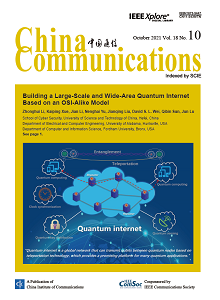面向工业边缘智能的数字孪生辅助半联合学习框架
IF 3.1
3区 计算机科学
Q2 TELECOMMUNICATIONS
引用次数: 0
摘要
边缘智能和数字孪生等新兴技术的快速发展为工业物联网(IIoT)的发展增添了动力。然而,IIoT 产生的海量数据、IIoT 设备的异构计算能力以及用户对数据隐私的担忧,都为实现工业边缘智能(IEI)带来了挑战。为了实现工业边缘智能(IEI),我们在本文中提出了一个半联邦学习框架,其中一部分隐私性较高的数据保存在本地,另一部分隐私性较低的数据则有可能上传到边缘服务器。此外,我们还利用数字孪生,通过物理实体的映射来克服 IIoT 设备计算能力异构的问题。我们提出了一个同步延迟最小化问题,该问题联合优化了边缘关联和上传非私有数据的比例。由于该联合问题具有 NP 难度和组合性,同时考虑到大规模设备训练的现实情况,我们开发了一种多代理混合行动深度强化学习(DRL)算法来寻找最优解。仿真结果表明,与基准算法相比,我们提出的 DRL 算法可以减少延迟,并在半联合学习中具有更好的收敛性能。本文章由计算机程序翻译,如有差异,请以英文原文为准。
Digital twin-assisted semi-federated learning framework for industrial edge intelligence
The rapid development of emerging technologies, such as edge intelligence and digital twins, have added momentum towards the development of the Industrial Internet of Things (IIoT). However, the massive amount of data generated by the IIoT, coupled with heterogeneous computation capacity across IIoT devices, and users' data privacy concerns, have posed challenges towards achieving industrial edge intelligence (IEI). To achieve IEI, in this paper, we propose a semi-federated learning framework where a portion of the data with higher privacy is kept locally and a portion of the less private data can be potentially uploaded to the edge server. In addition, we leverage digital twins to overcome the problem of computation capacity heterogeneity of IIoT devices through the mapping of physical entities. We formulate a synchronization latency minimization problem which jointly optimizes edge association and the proportion of uploaded nonprivate data. As the joint problem is NP-hard and combinatorial and taking into account the reality of large-scale device training, we develop a multi-agent hybrid action deep reinforcement learning (DRL) algorithm to find the optimal solution. Simulation results show that our proposed DRL algorithm can reduce latency and have a better convergence performance for semi-federated learning compared to benchmark algorithms.
求助全文
通过发布文献求助,成功后即可免费获取论文全文。
去求助
来源期刊

China Communications
工程技术-电信学
CiteScore
8.00
自引率
12.20%
发文量
2868
审稿时长
8.6 months
期刊介绍:
China Communications (ISSN 1673-5447) is an English-language monthly journal cosponsored by the China Institute of Communications (CIC) and IEEE Communications Society (IEEE ComSoc). It is aimed at readers in industry, universities, research and development organizations, and government agencies in the field of Information and Communications Technologies (ICTs) worldwide.
The journal's main objective is to promote academic exchange in the ICTs sector and publish high-quality papers to contribute to the global ICTs industry. It provides instant access to the latest articles and papers, presenting leading-edge research achievements, tutorial overviews, and descriptions of significant practical applications of technology.
China Communications has been indexed in SCIE (Science Citation Index-Expanded) since January 2007. Additionally, all articles have been available in the IEEE Xplore digital library since January 2013.
 求助内容:
求助内容: 应助结果提醒方式:
应助结果提醒方式:


